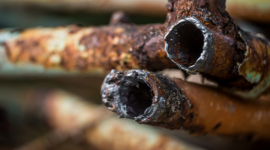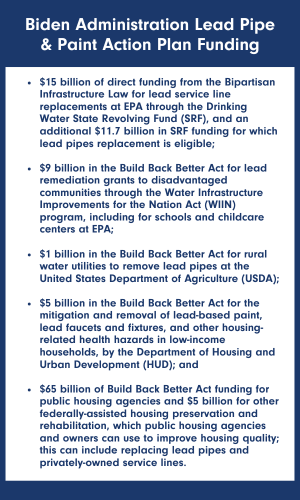Lead Service Lines and Replacement Efforts in Iowa
posted
by Sarah Howe on Tuesday, May 14, 2024
As communities across Iowa begin identifying their local LSLs and accessing federal dollars, IEC's Communications & Advocacy Associate Sarah Howe dug into the legacy of lead service lines (LSLs) and looked at updated information and resources from the DNR and federal resources to help Iowans as they think about their infrastructure needs.
What are lead service lines?

Lead service lines (LSLs) and galvanized steel lead lines are pipes used to distribute water from a water utility. These types of pipelines were widely used prior to 1900 and well into the 20th century, although there was research even then to suggest that lead exposure had detrimental effects to human health. In the United States, LSLs were allowed, and often mandated, until the 1986 Safe Drinking Water Act Lead Ban. Galvanized steel lead pipes wrap the lead pipe in steel, protecting direct water exposure to lead pipes, but the steel eventually rusts and degrades. This form of pipefitting is also largely outdated.
Lead is a known contaminant to drinking water, contributing to serious health and developmental problems for children and pregnant women. Exposure can cause a variety of effects, such as developmental delays, damage to the nervous system, fertility issues, mental illnesses, and kidney failure.
According to the CDC, “more than half of children in the U.S. are at risk of lead exposure – often in their own home.” Lead service lines are the leading cause of lead exposure in drinking water to individuals in the U.S., and the Biden Administration states that “10 million American households and 400,000 schools and child care centers are served by a lead service line or pipes and other fixtures.”
A 2021 study found that 76% of Iowa children under the age of six had detectable lead levels in their blood. That proportion is the fourth highest in the nation. The CDC says there is no blood lead level that is safe for children, but the department uses a reference value of 3.5 micrograms per deciliter to identify children with elevated blood lead levels. This exposure poses serious, lasting risks.
.png)
Having a lead service line does not necessarily mean you have elevated levels of lead in your water. However, lead can leach into drinking water as it moves through services lines and plumbing materials if they contain lead. This can happen when the pipes or fixtures are corroded, especially where the water has high acidity or low mineral content. The water that leaves a public water system must comply with federal drinking water regulations that control corrosion to prevent lead contamination.
The only way to combat prolonged lead exposure is to simply remove the lead pipes, fixtures, and goosenecks that distribute water to a tap. Although LSL replacement often means high investment costs and long waiting periods, action is already being taken by Iowa officials to systematically remove lead pipes.
Federal funding for LSL removal
 The Biden Administration’s Lead Pipe and Paint Action Plan accelerates the Bipartisan Infrastructure Law Investment to replace all lead pipes in the United States by 2031. This funding will also work to supplement existing statewide funding through Iowa’s Drinking Water State Revolving Fund (DWSRF). On April 10, Theresa Enright, SRF Coordinator, hosted a webinar on LSL replacement funding through the DWSRF, with special attention to eligibility and application requirements.
The Biden Administration’s Lead Pipe and Paint Action Plan accelerates the Bipartisan Infrastructure Law Investment to replace all lead pipes in the United States by 2031. This funding will also work to supplement existing statewide funding through Iowa’s Drinking Water State Revolving Fund (DWSRF). On April 10, Theresa Enright, SRF Coordinator, hosted a webinar on LSL replacement funding through the DWSRF, with special attention to eligibility and application requirements.
On average, it costs about $14,000 to replace a lead or galvanized steel lead service line. In Des Moines, for example, it will cost the city over $200 million to find and replace the 20,000 homes with outdated infrastructure. In other water systems, such as those with under 10,000 residents, LSL replacement has been prohibitively expensive without raising rates. However, the recent influx of federal funding can provide a path forward. Learn more about the Iowa DNR’s plans and resources for LSL replacement in public water systems on their webpage.
LSLs in Iowa & local programs
The Iowa DNR is developing a Lead Service Line Inventory which must be completed by October 16, 2024. This statewide inventory is mandated from the EPA’s 2021 Lead and Copper Rules Revisions (LCRR), which requires public water systems to identify and share the locations of lead, non-lead, and unknown service leads in a comprehensive inventory. The DNR’s Drinking Water Portal – Public Water Supply Dashboard offers Iowans the opportunity to submit LSL records for their property. The DNR is also developing a tool that public water suppliers can use to check their LSL inventories for errors.
Although it is currently unclear just how many LSLs exist throughout Iowa, many municipal utilities are already making headway to remove and replace their outdated infrastructure. Des Moines Water Works (DMWW) issued a statement that roughly 20,000 service lines were installed before 1940, and DMWW is developing a Lead Reduction Pilot Program to replace 100 LSLs in the River Bend and King Irving neighborhoods. In Dubuque, the city’s LSLs Replacement Pilot Program secured funds, and the city has already begun to replace approximately 575 private LSLs at applicants’ homes.
For many of these programs, as well as the funding provided by the Lead Pipe and Paint Action Plan, economically disadvantaged communities will receive priority for LSL replacement. This is in alignment with the Biden Administration’s Justice40 Initiative and environmental justice targets throughout the state.
.gif)
Issues with replacement
LSL replacement can be challenging. It often falls in a gray area of ownership and responsibility between public water distribution and private homeowners. Homeowners may have updated copper pipes in their house, while the public system has lead or galvanized steel lead pipes, thereby still risking contaminating the water. Homeowners with tainted infrastructure may not have the funding or capacity to update their pipes and reconnect to the public system. In the case of Des Moines Water Works, the homeowner owns the entire line to the water main, unlike the split ownership of the line as shown in the figure above. These differences ultimately fall between the utility service responsibility and the homeowner responsibility, making it difficult to understand where lead pipes are present and how to finance their replacement.
If you’re unsure whether you have LSLs, locate the pipe that connects to your home’s water meter. Magnetic, rusted pipes are likely galvanized steel pipes that connect to a lead pipe. Generally, lead and galvanized steel pipes have silver and grey colorings, while copper pipes have a red hue. If you’re located in Des Moines, the city offers an address lookup to see if your water is exposed to lead. Elsewhere, contact your municipal water utility with concerns regarding LSLs in the pipework distributing to your home, or use this tool from the National Public Radio.
- clean water
- clean water act
- dnr
- drinking water
- federal funding
- inflation reduction act (ira)
- public health
- water quality